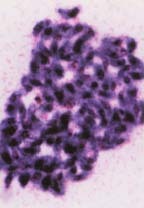Toxoplasmosis

Toxoplasmosis (tox-o-plaz-MO-sis), often called toxo, is a parasitic infection that usually causes no symptoms in healthy people, but it can be serious in people with weak immune systems and in unborn babies.
KEYWORDS
for searching the Internet and other reference sources
Parasitic diseases
Toxoplasma gondii
Zoonoses
What Is Toxoplasmosis?
The parasite Toxoplasma gondii, the organism behind toxoplasmosis, is found in soil and can infect humans and many species of animals. It is often found in cats, and is passed in cat feces (FEE-seez, or bowel movements). Touching dirty litter from a cat's litter box is one common way that people contract the parasite. Eating undercooked meat or accidentally eating contaminated soil are other ways that people become infected.
Many people who have toxoplasmosis have no symptoms or symptoms that are very mild. However, women who become infected when they are pregnant can pass the organism to the fetus * . In an unborn child, the parasite can cause congenital * toxoplasmosis, a condition that can range from mild to severe and may involve developmental problems and mental retardation, seizures * , and vision problems. Toxoplasmosis also can take a heavy toll on people with weakened immune systems, such as those with AIDS * or cancer, or those who have had an organ or bone marrow * transplant. Toxoplasmosis may affect the brain in these people.
How Common Is Toxoplasmosis?
The U.S. Centers for Disease Control and Prevention estimates that as many as 60 million people in the United States have been infected with T gondii, but cases of actual disease are much less common. Most people who carry the parasite have no symptoms of illness.
* fetus (FEE-tus) is the term for an unborn human after it is an embryo, from 9 weeks after fertilization until childbirth.
* congenital (kon-JEH-nih-tul) means present at birth.
* seizures (SEE-zhurs) are sudden bursts of disorganized electrical activity that interrupt the normal functioning of the brain, often leading to uncontrolled movements in the body and sometimes a temporary change in consciousness.
* AIDS, or acquired immunodeficiency (ih-myoo-no-dih-FIH-shen-see) syndrome, is an infection that severely weakens the immune system; it is caused by the human immunodeficiency virus (HIV).
* bone marrow is the soft tissue inside bones where blood cells are made.
* cysts (SISTS) are shell-like enclosures that contain a small organism in a resting stage.
Is Toxoplasmosis Contagious?
Pregnant women who are infected during pregnancy can pass the organism to the unborn child, but this is the only way that it spreads from person to person. Many people contract toxoplasmosis from eating raw or undercooked meat containing the parasite's cysts * , especially pork and lamb. Others unknowingly ingest the parasite's eggs after touching cat feces, soil, or anything that has come into contact with cat feces. The eggs can stick to a person's hands and may eventually end up in the mouth, where they can be swallowed.

What Happens to People with Toxoplasmosis?
Most people with the infection have no symptoms. When symptoms do occur, they may include swollen lymph nodes * , muscle aches, headache, and sore throat. For people with weakened immune systems (especially those with AIDS), toxoplasmosis can cause severe infection of the brain or, less commonly, the lungs or heart. As a result, symptoms are worse, and they may include fever, headache, confusion, seizures, blurred vision from inflammation of the retina * , psychosis (sye-KO-sis, form of mental illness in which an individual becomes disconnected from reality), and problems with speech or movement. Severe disease can be fatal.
In some cases, infection in a pregnant woman induces a miscarriage * . Congenital infection in newborns may be marked by small body and head size, jaundice * , rash, fever, anemia * , inflamed retinas, and an enlarged spleen and liver. These children may develop blindness, mental retardation, learning disabilities, and other problems with the central nervous system (the part of the nervous system that includes the brain and spinal cord), such as seizures and difficulty controlling movements. Sometimes the developmental disabilities are present from birth and sometimes they do not appear for many months or years.
How Do Doctors Diagnose Toxoplasmosis?
If a doctor suspects toxoplasmosis, he or she will draw a blood sample and test it for evidence of the parasite. An eye doctor may use a special lamp called a slit lamp to check the eyes for abnormalities of the retinas. People with weakened immune systems who are more likely to develop a severe infection might have magnetic resonance imaging * (MRI), a computerized tomography * (CT) scan of the head, or rarely, a brain biopsy (removing a small sample of brain tissue to examine) to look for signs of damage caused by the parasite. Infants with congenital toxoplasmosis also will need a CT scan of the head and thorough examination of other areas of the body possibly affected by the parasite.
What is the Treatment for Toxoplasmosis?
People who have toxoplasmosis but are otherwise healthy do not need any treatment. However, people with weak immune systems, pregnant women, and newborns with the congenital infection are treated with medication. Patients with AIDS often continue taking the medicine even after the infection clears up to keep it from returning.
* lymph (LIMF) nodes are small, bean-shaped masses of tissue that contain immune system cells that fight harmful microorganisms. Lymph nodes may swell during infections.
* retina (REH-tih-nuhz) is the tissue that forms the inner surface of the back of the eyeballs; it receives the light that enters the eye and transmits it through the optic nerves to the brain to produce visual images.
* miscarriage is the ending of a pregnancy through the death of the embryo or fetus before birth.
* jaundice (JON-dis) is a yellowing of the skin, and sometimes the whites of the eyes, caused by a buildup in the body of bilirubin, a chemical produced in and released by the liver. An increase in bilirubin may indicate disease of the liver or certain blood disorders.
Healthy people usually have symptoms for only a few days, if at all. In newborns and patients with unhealthy immune systems, the illness can last for weeks or months and cause permanent disability.
* anemia (uh-NEE-me-uh) is a blood condition in which there is a decreased amount of oxygen-carrying hemoglobin in the blood and, usually, fewer than normal numbers of red blood cells.
* magnetic resonance imaging (MRI) uses magnetic waves, instead of X rays, to scan the body and produce detailed pictures of the body's structures.
* computerized tomography (kom-PYOO-ter-ized toe-MAH-gruh-fee) or CT, also called computerized axial tomography (CAT). is a technique in which a machine takes many X rays of the body to create a three-dimensional picture.
Diseases Associated with Cats
- Cat-scratch disease: an infectious illness that can cause swollen lymph nodes and symptoms similar to those of the flu. It is caused by bacteria carried in cat saliva that usually enter the body from a cat scratch or a bite that breaks the skin.
- Cryptosporidiosis (krip-toh-spor-id-e-O-sis): an intestinal infection caused by a parasite that can live in people and animals, including cats. People pick up the parasite through contact with infected feces and typically have diarrhea and stomach pain.
- Giardiasis (jee-ar-DYE-uh-sis): an intestinal infection caused by a parasite that can live in people and animals, including cats. People become infected when they come into contact with feces from an infected person or animal and typically have diarrhea and an upset stomach.
- Lyme (LIME) disease: a bacterial infection spread to humans by the bite of infected ticks, which can be carried by cats. The illness starts with a distinctive rash and/or symptoms like those of the flu and can progress to a more serious disease with complications affecting other body organs.
- Rabies (RAY-beez): a viral infection of the central nervous system that usually is transmitted to humans by the bite of an infected animal.
- Ringworm: a fungal infection of the skin, scalp, or nails that usually causes red, dry, flaky skin. The fungus also can infect pets such as cats, which can spread the fungus to people.
- Toxocariasis (tox-o-kah-RYE-uh-sis): an infestation in people of a type of parasitic roundworm found in cats (another species is found in dogs). As the worms move through the body, they can affect the eyes and other body organs.
- Toxoplasmosis: a parasitic infection often found in cats, and is passed to humans through contact with cat feces.
Can Toxoplasmosis Be Prevented?
Pregnant women and people whose immune systems are weak can take steps to avoid infection with T. gondii. First, they can be tested for the parasite. If they test positive, they will likely be started on medication for the infection, even if they do not have any symptoms. If they test negative, they can follow some simple measures to keep from becoming infected in the future, such as:
- wearing gloves when gardening and handling soil to prevent infection from parasites in the dirt
- wearing gloves when cooking or having someone who is healthy and not pregnant handle raw meat
- cooking all meat thoroughly, until the juices run clear and it is no longer pink inside
- washing all utensils and cutting boards that have come into contact with raw meat in hot water and soap
- washing hands frequently, particularly after outdoor activities, after preparing food, and before eating
- keeping family cats inside and feeding them only dry or canned cat food, because cats can pick up the parasite from eating raw meat
- having someone who is healthy and not pregnant change the cat's litter box every day
- not touching strange or stray cats or letting any cat into the home that might have lived outside or eaten raw meat
Resources
Organization
U.S. Centers for Disease Control and Prevention (CDC), 1600 Clifton
Road, Atlanta, GA 30333. The CDC is the U.S. government authority for
information about infectious and other diseases. It provides information
about toxoplasmosis at its website.
Telephone 800-311-3435
http://www.cdc.gov
Website
KidsHealth.org
. KidsHealth is a website created by the medical experts of the Nemours
Foundation and is devoted to issues of children's health. It
contains articles on a variety of health topics, including
toxoplasmosis.
http://www.KidsHealth.org
Comment about this article, ask questions, or add new information about this topic: